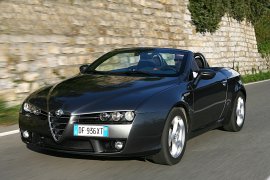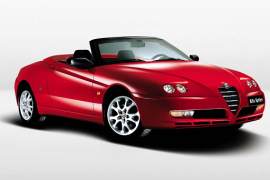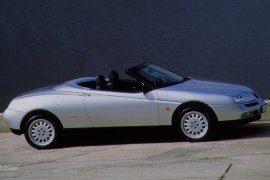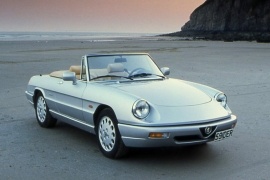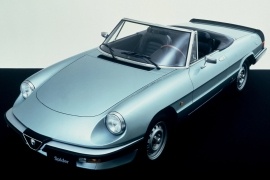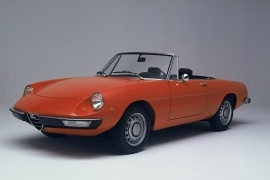ALFA ROMEO Spider Models/Series Timeline, Specifications & Photos
First production year: 1970
Engines: Gasoline, Diesel
Body style: Convertible (spider/spyder, cabrio/cabriolet, drop/open/soft top)
In 2008, at the Geneva Motor Show, Alfa Romeo introduced an updated version for the Brera coupe and the Spider version. Both cars featured the same front fascia with the 159 model range.
Alfa Romeo kept an open-top vehicle in its lineup almost all the time. After the GTV Spider was pulled out of production in 2004, there was a gap that needed to be filled. But there were some years until the new soft-top appeared on the Italian company stable.
From the outside, the three-headlights design of the front was used, along with the big Alfa Romeo shield in the middle. The design was signed by Pininfarina and it featured a long hood and short cabin and trunk lid in the back. The raked windshield helped to improve the drag coefficient.
Inside, there were two seats separated by a massive center console. Some parts of the interior were carried over from the bigger Alfa Romeo 159, along with the steering wheel and the instrument cluster.
The platform was created in a joint-venture with General Motors, after a failed takeover of the Italian group by the American company. The V6 engine was also carried over from the Australian branch of the GM. But the result was far from satisfactory. The car was heavy. With the V6 and all-wheel-drive system, it had a high fuel consumption. The turbodiesel had better fuel-efficiency but it was not the choice for the roadster buyers. The 1.8-liter turbocharged version was too weak and also, had a high fuel consumption.
Starting with 1993, Alfa Romeo offered its first front-wheel-drive Spider to the market, and after five years, it added a mid-life cycle refresh then, another one, in 2003 for the last mile before a complete change.
The Italian brand managed to create beautiful cars over its long history, and the 2003 Spider was one fine example. It tried to live up to its badge and showed respect to its owners, at least from the aesthetic point of view.
When launched in 1993, the Spider was one of the best-looking cars in its segment, and the 2003 refresh just kept that advantage alive. At the front, it had the same round headlights under the hood but with different headlamps. Pininfarina's designers changed the hood and the front bumper creating a deep Alfa Romeo shield with horizontal slats, in the same spirit of the 147 range. But changes to the exterior stopped there.
For the interior, the biggest change was for the air vents. Unlike its predecessors from the 1993 and even the 1998 model, the 2003 version sported round, flap-style vents on top of the center stack and on the sides. They looked better suited to the overall interior design, even if they were carried over from the Fiat Punto. Alfa Romeo also moved the power-mirrors buttons further back. They were harder to reach, but their spot was needed for a small storage space, which was more useful in a daily driving situation. After all, how many times a driver adjusts the mirrors?
Under the hood, Alfa Romeo kept only one engine from the 1996 model, a 2.0-liter that provided 150 hp. The other two options were new for the car: a 2.0-liter with direct fuel injection and a GM-sourced 3.2-liter V-6. There were no automatic transmissions available.
Alfa Romeo introduced the second generation of the Spider in 1995 after it retired its three-decades-old predecessor.
Few cars in the world attracted so much hype as the Alfa Romeo Spider, but that attraction was primarily for the 1966 model produced until 1994, not for its successor. Even though it was a much better car by any means, it couldn't get the same emotion as its predecessor. The Italian carmaker built the 1995 model on Type Two (Tipo Due) platform shared with Fiat Tipo and Lancia Delta. Alfa Romeo also used it for the Spider's coupe sibling, the GTV.
While Bertone made the 1966 model, Pininfarina designed its 1995 successor. The narrow front end and four individual headlamps made the car unique on the market. Between them, on the hood, the carmaker installed the Alfa-shield specific feature between the broad and narrow grilles installed in the upper side of the bumper. Alfa Romeo offered an option for a set of fog lights above the apron on the lower side. From its side, a clear-cut ascending line linked the front wheel-arches with the back of the cabin, while the short trunk continued in a sloped-down line.
Inside, the carmaker installed two bolstered bucket seats with cloth upholstery for the base version or a leather-clad interior for the full-spec variants. Its dashboard featured a binocular-style cluster with individual clusters for the tachometer and speedometer.
Under the hood, Alfa Romeo introduced the Spider with a 16-valves, two-liter engine. Later on, in 2001, the carmaker added a 3.0-liter V-6 powerplant, which sported a polished intake manifold that looked glorious.
After almost a quarter of a century, Alfa Romeo prepared a final update for its classic roadster, the Spider.
The Spider was one of the most iconic cars built by the Italian carmaker after WWII. Even if Alfa Romeo didn't sell it in huge numbers, it remained a classic car that combined the driving pleasure with a touch of luxury. In 1990, the carmaker introduced a few upgrades.
On the outside, the car was almost the same as the original 1966 model but sported new bumpers both front and rear. Its round headlights with chromed rings around them remained in position. At the back, the long-tail design and the new, wrapped-around bumper looked natural for a 1990 vehicle. Alfa Romeo also changed the taillights, trying to have a modern look.
Inside, the Italian carmaker offered the Spider in two trim levels. While the base version featured cloth seats and nothing more, the Veloce top-trim level sported leather seats, air-conditioning, and a stereo-cassette player. Its in-dash mounted gear stick was a tribute paid to the old '60s platform used by Alfa Romeo. Unlike most of its competitors who lacked in that area, the trunk was big enough for a long journey, unlike most of its competitors. Its two-seat interior was good for the '60s, but in the '90s, it was already too small, with a windshield too narrow.
Under the hood, Alfa Romeo managed to install a 2.0-liter engine fed by a fuel injection system. That improvement raised the power and lowered the fuel consumption for the little roadster. It was paired as standard with a five-speed manual gearbox, while the carmaker offered a three-speed automatic as an option.
Alfa Romeo introduced the third series of its original 1966 Spider in 1983 and improved it over its predecessor in every way, without losing its sex appeal.
At the beginning of the '80s, the new safety regulations were stricter, and the carmakers had to adapt their models. Some just added fatter bumpers, which made the designers annoyed, while others tried to integrate the mandatory features into the original shape. Alfa Romeo took the second path, even though it was a harder road.
For the 1983 model, the light and nimble Spider kept the original design as a two-seat roadster with only the windshield poking up the sky above the beltline. At the front, the car featured a new hard rubber bumper with integrated turn signals and parking lights underneath it. The round headlights stayed in their place with a similar design and chromed rings around them. An apron was slightly extended behind the bumper. Alfa Romeo offered a removable hardtop with a glass windscreen in the back for colder days.
The two-seat cockpit was heavily revised. The dashboard was modern and featured a radio-cassette player mounted on the center stack, just above the angled gear stick and under three-round vents. An instrument panel with more dials arranged into a semi-circular layout showed a better view for the driver. Even the seats were enhanced with bucket seats but no bolstering.
Under the hood, Alfa Romeo installed a 2.0-liter twin-cam engine. In Europe, the carmaker offered it with three carb-choices: Solex, Weber, or Delorto. The Italian carmaker chose to play safe with the emission tests and installed a Bosch mechanical fuel-injected system for U.S. customers.
Alfa Romeo introduced the Spider on the market in 1966, becoming a desirable car despite its low power output, and in 1970, the Italian automaker refreshed the roadster.
With a design signed by Pininfarina and spirited engines, the Spider was a real success on both sides of the pond. Still, there were some voices that didn’t like the sloped rear end of the car in the U.S., so the Italian automaker considered remaking it for the second series of the open-top vehicle, which was introduced in 1970. In addition, the automaker offered a lower-spec version that made the car more affordable for many customers who couldn’t afford the more expensive engine variants.
For the 1970 model year, the Spider received a modified front fascia for the U.S. version. The European one got the same bumper, but over the Atlantic, it got thicker ones to pass the 5 MPH (8 kph) crash-test regulation. Furthermore, the American customers’ vehicles had turn signals with amber lenses on them, while those from the Old Continent had a parking/blinkers combo there. The headlights for both versions were still the same round units as before.
From its profile, the car’s front fenders received round blinkers in Europe and rectangular, bigger ones in the U.S. In addition, Alfa Romeo noticed that some customers didn’t like the boat-tail rear end of the vehicle, so it altered it with a Kamm-back design. It means that the rounded rear end had a straight, vertical cut and featured a flat panel where the rectangular taillights were mounted, with thin and vertical reversing lights on their inner side.
The Italian automaker also improved the cabin. While it was still fit for just two adults, it also featured a rear parcel shelf behind the seats, which became the most used storage space. Fronting the driver was a small instrument panel where Alfa Romeo installed two wide dials for the rev counter on the left and the speedometer on the right. In addition, on the center stack, the automaker added three other gauges for the fuel level, the oil pressure, and the coolant temperature. All these Jagger instruments wore the carmaker’s badge printed in white on black dials and white needles. On the center console, the automaker placed the gear stick, and below it, the buttons for the parking lights, the wipers, and the fan. The car didn’t have an AC option. Still, it featured a sliding control next to the gear stick that allowed some cold or warm air into the cabin, blowing through four round vents mounted on the dashboard’s center and on the sides.
Under the hood, Alfa Romeo introduced a new 1.3-liter engine in the lineup. It was carried over from other vehicles and produced just enough power for those craving an open-top vehicle and fuel-efficient engines. Later, in 1971, the automaker brought a 2.0-liter fuel-injected engine paired with a five-speed manual gearbox.
